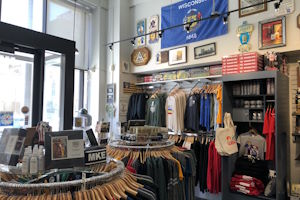Classical
Behind the curtain
This month, to an even greater extent than usual, you can leaf through the pages of VITAL and find calendar listings, phone numbers, websites and profiles of the people that power the ships, as well as evidence, photographic and otherwise, of creative output. With a little imagination you can envision a setting: a proscenium stage, a row of footlights, dusty makeup rooms and wardrobes stuffed with spangled costumes. You might think about musical instruments or ballet shoes, or you might imagine the barely-controlled chaos of ticket offices and sales departments. But what else happens inside a performance company? And how wide of an audience do arts groups reach? What is their relevance or value to the wider world? The truth is, with public schools more strapped for cash than ever and cultural resources dwindling, arts organizations are sometimes a community’s most powerful force for education, outreach and enrichment resources. Members and affiliates of the United Performing Arts Fund alone touch over a million people every year, including more than 400,000 area children, according to UPAF Vice President of Community Relations and Marketing Linda Edelstein. Here, four major Milwaukee arts institutions share their most compelling initiatives for the coming season and the value they’ve brought to the city. Training and growth It’s a big year for the Milwaukee Ballet, whose acclaimed Ballet School is rated among the very best in the nation. In late August the School opened its largest branch at the Sendik’s Towne Centre in Brookfield, and this fall, the ink should be dry on the accreditation forms sent in to the National Association of Schools for Dance. If accredited, the Milwaukee Ballet School – established in 1975 – will be the only dance institution in the region that has met the NASD’s standards. But the Ballet’s outreach programming extends beyond sprung dance floors, lofty studios and kids in tutus. Their education programs alone reach over 20,000 kids a year through in-school performances, workshops and collaborations with other arts organizations. Merging training, performance, enrichment and the continuity that a successful arts education program requires, Relevé, an inner city youth dance program, provides ballet training to over 175 students at four MPS elementary schools: Allen-Field, Dover, Maple Tree and Vieau. Children start small with once-a-week, in-school ballet classes in 3rd grade and advance through 4th and 5th grade with training at the Milwaukee Ballet studios in the Peck Center. All of their dancewear is provided for free, and their study is enriched with free tickets to shows at the Ballet, in-school performances, meeting with company dancers and end-of-the-year recitals. “Relevé allows us to work with girls – and boys – who wouldn’t otherwise see these same kinds of opportunities,” says Alyson Vivar, Director of Education at the Ballet. “They really learn so much more than ballet – they learn discipline and self-confidence, and they have fun.” Training young people doesn’t have to stop with school kids. Art depends on fresh faces and the collision of new ideas with established practices […]
Sep 1st, 2008 by Amy ElliottNew directors, new directions
The day I found out that the Milwaukee Symphony Orchestra would be announcing the music director to replace Andreas Delfs after the 2008-2009 season, I went to bed wondering when the Milwaukee Art Museum would get their ducks in a row and pick someone to replace Director and CEO David Gordon, who will be leaving in March. I didn’t have to wonder long — I got an email the next day from the MAM press team announcing that a “successful museum director,” Daniel T. Keegan, would be taking the job. After months of what I imagine to have been sweaty deliberation, secret rehearsals, googling for dirt, maybe even confessional audition tapes, two of the city’s brawniest art organizations rang in the new on the same day. Their choices make sure statements about how they see themselves and where they hope to head in the next few years. The Symphony’s choice, Edo de Waart, is absolutely magnetic. At 23 he served as Leonard Bernstein’s assistant conductor at the New York Philharmonic; over the course of a storied, cosmopolitan career, de Waart has conducted the Royal Concertgebouw Orchestra in Holland, the Rotterdam Philharmonic, the Sydney Symphony Orchestra and most recently the Hong Kong Philharmonic. Edo de Waart also brings an extensive catalog of recordings with a number of orchestras on major music labels. In person he is full of European charisma — funny but focused, comfortable and sincere. He just moved to Middleton with his wife and family, but everyone, including Edo, went to lengths yesterday to stress that this is not a late-career move made out of ease or laziness. De Waart called the MSO “a great sleeper orchestra,” unfettered by the weighty reputations that sometime “exceed reality.” In the past he has spoken with impressive conviction about what a wonderful symphony orchestra can do for a smaller city, or a city in transition (take a look at this interview about his work with the orchestra in Hong Kong). His experience in opera conducting — including but not limited to the Met in New York and L’Opera National in Paris — as well as a track record of taking chances on contemporary composers and lesser-known repertoire should prove revitalizing to the MSO. And I think Milwaukee is going to love him. Daniel T. Keegan, a different choice for a different beast, comes to the Milwaukee Art Museum from the San Jose Museum of Art, rather persistently described in the press so far as a “Silicon Valley museum.” The phrase gives a lot away about what MAM was looking for in its new leader; San Jose’s most notable distinction, besides its expansive collection of West Coast and Pacific Rim art, is its use of technology and multimedia in exhibitions and galleries. Their podcasts are award-winning, and you can dial their audio guides from your cell phone. The Milwaukee Art Museum has been reaching for a savvier demographic — a multi-tasking, wireless, gadget-infatuated and quick-on-its-feet group of people — for some time, with […]
Jan 4th, 2008 by Amy ElliottThe song remains the same?
By Ellen Burmeister Once regarded as the epitome of the excesses of the 1970s rock landscape, Led Zeppelin is currently undergoing a revival of sorts, which is expected to culminate in a much-heralded reunion concert in London this December. For those of us who can’t book a flight to Heathrow, an admirable substitute came to the Riverside Theater November 9 as a 50-piece subset of the Milwaukee Symphony Orchestra. Under the direction of composer/arranger Brent Havens, they presented “The Music of Led Zeppelin”, a “rock symphony” of fifteen of the band’s best loved tunes. Notching up the rock chops of the ensemble were – most notably – vocalist Randy Jackson, guitarist George Cintron, electric violinist Allegra, and drummer Powell Randolph (granting the crowd a sampling of a truly Bonham-worthy solo on “Moby Dick”). While no one can match the vocal acrobatics and writhing tight-pants sensuality of Robert Plant at his peak, Randy Jackson proved that the art of rock vocals is a worthy equivalent to that of any other highly trained vocal discipline, especially when backed by a professional ensemble. Almost academic in his approach, Jackson gave a thrilling “reading” of the varied styles in the Led Zepplin playbook – classic rock, blues, and even English folk – and played some great acoustic guitar as well. Kudos to guitarist Cintron and violinist Allegra as well. Jimmy Page’s fabulously inventive and complex riffs got their due props thanks to this unique splitting and doubling of his musical vision among these two talented musicians, particularly on “Black Dog” and “Heartbreaker.” And – despite the challenges of competing with an amplified bass line that approached “11” – the Milwaukee Symphony Orchestra brought a rich timbre to the tracks. Subtle changes such as the addition of an oboe to the flute meanderings on “Stairway to Heaven” or the lush backup lines on “In the Evening” reminded the appreciative audience of the beauties hidden in tracks so often taken for granted. And of course, “Kashmir” never sounded more exotic or epic as when a full orchestra takes on its throbbing rhythm and evocative harmonics. The capacity crowd was visibly proud of its hometown orchestra (a terrific outreach project for the MSO if there ever was one) and participated wholeheartedly in every opportunity for interaction that arose. By the time “Stairway” reared its ubiquitous head (complete with the rarely heard guitar and vocal prelude), there was an overwhelming sense of satisfaction in the crowd. No one was alarmed by bustles in their hedgerows. VS
Nov 12th, 2007 by Vital ArchivesThe 25th Annual Putnam County Spelling Bee
The spelling bee dates back to the early nineteenth century, and what may have started as a celebration of literacy in a largely agrarian nation has become a common feature of childhood culture familiar to people all over the country. One slice of Americana meets another in The 25th Annual Putnam County Spelling Bee — a musical about the fictitious bee of an insular county that could be anywhere in the country. The musical, which opened at the Marcus Center this past Tuesday and runs throughout the week, is patterned after an actual spelling bee. There are grade school-style standing displays in the lobby and a desk for anyone in the audience who wants to sign up for the bee. At the beginning of the show, half a dozen audience members are called to the stage to compete. The show is performed without intermission and, strangely enough for a musical, with relatively little singing. Songs are short, inconsequential and as memorable as a fifteen-second television commercial. The result is a passably enjoyable comedy full of spelling-bee jokes and deft language-play that would be great if it weren’t for all those songs breaking the pace of the laughs. While music drags the production in numerous places, Spelling Bee is entertaining as a character comedy. The spellers are diverse: Logainne Schwartzandgrubenierre (Dana Steingold), the precocious ultra-liberal daughter of two gay dads; William Barfee (Eric Roediger) an awkward kid with a unique spelling technique; Olive Ostrovsky (Vanessa Ray ), the child of distant parents; eccentric Leaf Coneybear (Andrew Keenan-Bolger), whose spelling abilities seem to come from nowhere; multi-talented ultra-perfectionist Marcy Park (Katie Boren) and sexually frustrated Boy Scout Chip Tolentino (Justin Keyes). James Kall has a brilliant sense of comic delivery as Vice Principal Douglas Panch, who officiates the bee with former champion Rona Lisa Peretti (Roberta Duchak). The touring production uses the old trick of dropping local references like Brett Favre and Brady Street. Still, nothing can top the craziness of inviting actual audience members to compete in the bee. It’s staged – the audience members are gone by the time the first couple of characters are eliminated – although on opening night, one woman didn’t get cut as expected, even managing to spell a word that had been entirely fabricated for the musical. Her turn came up again immediately, and she politely misspelled a much longer word. A show that so clearly welcomes this kind of controlled audience participation has a clever charm to it. VS The 25th Annual Putnam County Spelling Bee runs through November 11th at the Marcus Center. Tickets can be purchased in advance by calling the box office at 414-273-7206 or online at www.marcuscenter.org. December 11 – 16, the touring company makes its way to the Fox Cities PAC in Appleton. For more info, visit www.foxcitiespac.com
Nov 8th, 2007 by Russ BickerstaffIan Ball
Fans of Southport, England’s Gomez have long realized that with three songwriters in the band, there was bound to be a bit of venturing into solo-land, for true-blue songwriters can only collaborate and play nice for so long. Ian Ball has no desire to see his outfit disband, but is keen to try some orchestrations of his own, which are in turn are subtly lovely, genuine, organic and pleasing in their simplicity. It’s fair to call Who Goes There “piano-driven,” but don’t let that lead you to think this is a typical boy-and-his-piano heartstring-tugger. Rather, Ball has mastered an uncanny knack to make the absence of guitar largely unnoticeable. Instead, he magically manages to serve up a heavy rotation of a crunchy Fender Rhodes, mellow acoustic piano, electronic loopery and glass-clear glockenspiels that override the soft strummings of acoustic guitar in a playful way, lending a fresh sound to songs of love and its trials, which are lyrically a little cheeky, but never campy. Ball even manages to make getting high from enough drugs to tranquilize an elephant (“The Elephant Pharmacy”) sound charming. Ball’s skills as a solo artist lie in his ability to bring living-room ballads uncannily within reach, despite his intensely personal storytelling style. From the introspective, self-soothing opener “Sweet Sweet Sleep” to the bouncy “Automatic Message” and whimsical “When We Were Cool,” Ball doesn’t get in anyone’s face – just garners slow, but solid, appreciation. VS
Nov 5th, 2007 by Erin WolfJimmy Eat World
‘Emo’ was once considered a four-letter word, yet one of the founding bands of this genre, Jimmy Eat World (along with the likes of Rites of Spring, Sunny Day Real Estate and Braid), managed to give it staying power. From 1993 onward, the band that once did split 7” records with Jejune and Christie Front Drive has evolved into a Warped Tour member and is name-checked with Green Day and Taking Back Sunday. Taken aback by their success, the band has been seemingly cornered into re-creating and advancing this once fresh sound, moving it from its hardcore/punk roots into a bubblegum pop vocalists’ headbanger’s ball. In the process, Jimmy Eat World’s trademark sound, which began with 1999’s Clarity, shifted the majority of the vocals from Tom Linton’s scratchy emo-core rasp to Jim Adkins’ more pure tenor choirboy vox. Perhaps this was the switch that fixed Jimmy Eat World’s rising popularity, but at a heavy price. None of the once truly poignant words remain. On Chase This Light, the lyrics seem bled dry of anything heartfelt, the songs sliding from one to the next, not effortlessly, but unnoticeably. Gone are the days of the intense but admirable balance of adrenaline-bomb hooks and dramatic epics with electronic noodling (innovative in its day). This stagnant direction is surprising, since their last release in 2001 had them leaning back to their grittier Static Prevails days. Only “Firefight” and “Feeling Lucky” recall the band’s original sound. Venturing into new territory, “Gotta Be Somebody’s Blues” gives off a smoke-machine, Def Leppard vibe with its excessive strings and over-produced vocals. Even Jim Adkins’ contribution – “Carry You,” from his side project Go Big Casino, and which could be said to be more true-blue – still sounds contrived and will soon be Muzak. Was it foresight that almost ten years ago on Clarity’s “Your New Aesthetic,” Adkins sang, “We’re lowering the standard in a process selective / the formula is too thin / but it takes more than one person / so everyone jump on / I’ll miss you when you’re just like them”?
Nov 1st, 2007 by Erin WolfBruce Springsteen
Bruce Springsteen’s career has been truly beyond reproach. Even those who aren’t fans have to acquiesce to the fact that he’s the definition of integrity in a business that thrives on the opposite. And while his popularity may have waned in the nineties, he still created provocative music that meant something both to him and to his audience. This is evidenced by recent releases from a number of young artists mining his sound and his aesthetic. Ah, but they could never be the real thing. And here in his 24th year of recording, Bruce produces yet another finely-crafted testament to his “Boss” title. Magic contains the most direct and immediate collection of rock music Bruce has put out since Born in the U.S.A. in 1984. The saxophone, the piano and the rest of the E Street Band are back in full regalia on songs like “Livin’ In The Future” and “I’ll Work For Your Love.” The driving rhythms, melodies and narratives are also back, particularly on “Last to Die.” But Bruce doesn’t stop there: on the title track he displays the entire spectrum of his talents as a creator. “Girls In Their Summer Clothes” is as innocent as it is wistful. And though it may turn some people off, there are also a number of songs that touch upon his acoustic, rootsy leanings, sparse and epic. Bruce makes albums that are the equivalent of audio novels. They tell stories, weave descriptions, paint landscapes and define characters. But he also always gives us a little prize wrapped in the theme of it all: the emotional resource that compels us to be the authors of our own existence. “Love (and attitude) is a power greater (and stronger) than death” he sings in his tribute to a deceased friend on the hidden track 12, “Terry’s Song.” Yep, that’s the magic.
Nov 1st, 2007 by Troy ButeroCitay
The average person does not listen to instrument-led rock music. At most, it’s used as background noise while cleaning, studying, or even sleeping – earning a position not much higher than a Sharper Image sound machine. Without prominent vocals, it’s easy for most to lose interest. Unless, like the not so itty-bitty eight-piece Citay committee, there is a generous amount of aggressive ‘70s guitar to demand attention. The noise comes when least expected, as during the unassuming Elliott Smith-like “On the Wings.”Since the disc’s undertones are mellow, these interjected rock-god moments are startling. Also surprising – and out-of-era – is the Metallica-meddling on “Former Child” which, thankfully, bows out a minute or so into the almost eight-minute track. Now, eight minutes may seem drawn out, but Little Kingdom is never difficult to connect with, even at its most noisy, lyrically free and instrumentally hefty. Not quite as kitchen-sink as today’s symphonic indie bands with as many members, Citay’s wackiest accessory is the mandolin. In addition, songwriter Ezra Feinberg plays nine instruments and provides tender vocals in select songs like the whimsical “First Fantasy.”Not only does he rival Sufjan Stevens in gratuitous musicianship, but also channels Sufjan’s minimalist, folksy vibe throughout “Moonburn,” the album’s closer – beneath the hell-raising retro guitar shredding, of course. If your Led Zepplin III or Pink Floyd Animals vinyl is wearing thin, Little Kingdom is an ideal segue into the current century. Apologies if it’s only released on CD.
Nov 1st, 2007 by Amber HerzogJames Luther Dickinson
As producer and musician, Jim Dickinson has had a hand in masterpieces by Aretha Franklin, The Rolling Stones, The Flamin’ Groovies, Big Star/Alex Chilton, Ry Cooder, The Replacements and Bob Dylan – not to mention raising his sons, The North Mississippi All Stars. As a solo artist, Dickinson released his debut in 1972 (the classic Dixie Fried) and waited thirty years before following it up. Reminds me of a joke my grandpa used to tell about “a long time between drinks.” Dickinson has picked up the pace significantly since; Killers From Space is his third album since 2002. His choice in material and the very way he inhabits a tune go a long way to defining that particularly indefinable brand of Memphis strange. Ranging from Tin Pan Alley to blues to gospel to all-out rockers, Dickinson’s weathered vocals put the listener front-row-center to characters that may be down and out, but have more soul than they can handle. “I Need You” reveals menace that in lesser hands would be camp. Here its wheezy harmonica and piano interplay suggests the last gasp of Jay Hawkins at St. James Infirmary. Dickinson is a national treasure; he should be on a postage stamp.
Nov 1st, 2007 by Blaine SchultzElement Everest
By Kenya Evans Life is a Heist tells the spiraling stories of the hood rich just trying to get by and delivers a verbal vengeance signed and sealed by Ms. Everest personally. The first and only lady of local hip hop group Black Elephant – 2006 WAMI runners-up for best unsigned artist – Element Everest (yes, her real name) is debuting her first solo album. She’s no stranger to MCing, writing rhymes and shutting down naysayers who criticize or question her authority as a female rap artist. Gritty and unapologetic, Life is a Heist booms with 808s, snares and brassy beats against Element’s smoky voice. The up-tempo “Intro” has the layered instrumentals of a marching band, dramatic and charged with musical action. “Good Girls,” the first single, which premiered on local radio station V100, is a sexy and sassy boy-meets-girl love song that’s mellow and made to groove to. Element upholds what Black Elephant does best – telling tales of the city, from grinding streets to head-bobbing beats – but brings a bit more soul to her own songs. Element sings a cappella on “The Wire,” reminiscent of an old Negro spiritual, channeling the stark realities of modern-day urban strife and the continuous struggle of black life: that there’s no difference between slaving in the fields to becoming slaves of the mind and products of an impoverished environment. “Katrina,” a duet with local guitarist/singer/songwriter Evan Christian, speaks for the dismal and discriminated New Orleans natives who were victims of a natural disaster and their own government. Overall, it’s rich and hard-hitting, both lyrically and musically: Element doesn’t play nice. Get ready to take a bite out of some ghetto melodies that bite back.
Oct 4th, 2007 by Vital ArchivesA matter of perspective
By Blaine Schultz, Jon Anne Willow and Kenya Evans + Photos by Kat Jacobs and Erin Landry In planning this story, we originally set out to pair young musicians with seasoned veterans and see what kind of school would be in session as a result. But what happened instead was vastly more interesting: organic dialogue stemming from a common love. What follows are three interviews with six musicians penned by three writers. The questions for each were different, as were the settings and interview styles. But the messages overlap, intertwine and paint a bigger picture of what it takes to live one’s passion. From creative process to overcoming jadedness to living with your choices, these six musicians laid it all out. Very special thanks to the Wisconsin Conservatory of Music for opening their doors for the photo shoots for this story. You’ll find more incredible images in our gallery at vitalsourcemag.com. —Jon Anne Willow Peder Hedman and Jason Mohr By Blaine Schultz + Photo by Erin Landry It is a too-warm September evening in Jason Mohr’s backyard, but nobody’s complaining. Bug spray and citronella candles help, but this year’s crop of mosquitoes arrived late and hungry. In a far-ranging conversation that spans Mohr’s thoughts on how a songwriter may be unconsciously predicting his own future to Hedman’s take on what it means to keep a band together when domestic realities come to the fore, it was never really obvious that two decades separate this pair of Milwaukee musicians. A common point of reference for both guitar mavens is the Maestro Echoplex, a vintage analog tape echo unit. Hedman brought to the interview a Stylophone, a gizmo he picked up at Value Village. The crude, handheld synthesizer may be best known as the instrument that plays the solo on David Bowie’s “Space Oddity.” The Peder Hedman Quartet is in the final stages of self-releasing Don’t Fall Down; Mohr’s group, Juniper Tar, is nearly ready as well with the provisionally-titled Free Bird. Both bands begin with interesting songs and then subtly warp them to their own needs. And make no mistake, the musicians who collaborate with Hedman and Mohr are as talented and beyond ordinary as you will find. “Take a look at this, the first press I ever got,” Hedman says, setting an age-yellowed copy of the Crazy Shepard on the table. The 1982 article profiles the Null Heirs, accompanied by a grainy black and white photo. Since then, bassist Mike Frederickson went on to form The Moseleys and play bass with Robbie Fulks; keyboardist John Duncan played with Gear Daddy Martin Zellar (and Tiny Tim); Kent Mueller ran the late KM Art. Hedman played in Liquid Pink, then Tweaker, which landed him down south for years. It’s a sharp contrast to Mohr’s less than a decade of band experience, highlighted by an EP with his previous group, Telectro. “If a tree falls in the forest and no one hears it … well, I’m making my mark,” Hedman says of his […]
Oct 1st, 2007 by Jon Anne WillowDan Kaufman/Barbez
There’s something undeniably mysterious about the sounds coming from Dan Kaufman/Barbez’s album Force of Light. Developed over the span of three years, Force of Light is a requiem to Holocaust survivor and poet Paul Celan. Scattered throughout the album are lines from Celan’s poetic discourse read by Fiona Templeton, a theatre director and renowned Scottish poet in her own right. Paul Celan remains one of the major poets of the post-World War II era. The death of his parents and his experience with the Holocaust are two central themes in his works. After receiving word of his parents tragic death in the camps, Paul writes, “And can you bear, Mother, as once on a time,/the gentle, the German, the pain-laden rhyme?” Just as his poetry is rich with feeling, Kaufman/Barbez’s works on Force of Light are on par with Celan’s devices. The opening track begins with a slow finger-picked chord progression on a nylon stringed guitar — dark and captivating, the climate catapults the listener into the realm of introspection. The music is accompanied by Fiona’s eloquent reading of Celan’s poem Shibboleth: “Together with my stones/grown big with weeping/behind the bars/they dragged me out into the market/that place/where the flag unfurls to which/I swore no kind of allegiance.” As the words of the poem take shape, chimed instruments are thrown into the mix, creating an overall eerie air. The track draws visions of shadowed figures in pantomime. Kaufman spent years working on this album, including a month in Berlin in solitude beneath images of the Holocaust. The result is an album that not only covers a wide musical terrain, but touches a collective human quality. From clarinets to theremin, to marimbas and violin, Force of Light is a lush auditory feast. The arrangement of sounds, along with Fiona’s reading of Celan’s poetry, is a perfect mesh that keeps the listener in limbo and often teetering on feelings of hopelessness and despair.
Oct 1st, 2007 by Blaine Schultz

















